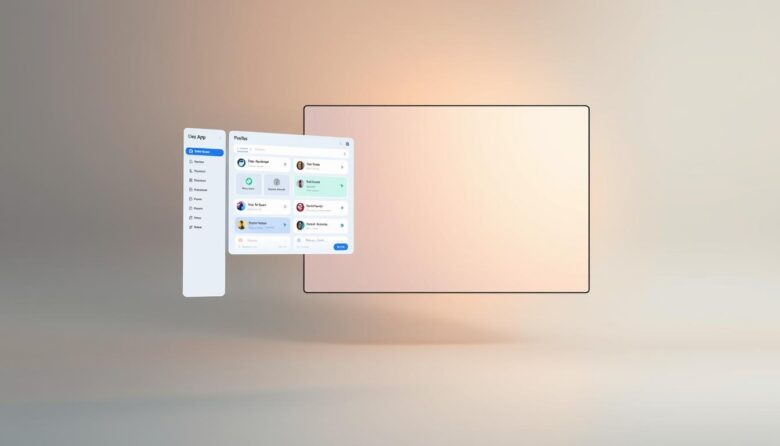Creating professional software no longer requires years of coding expertise. Modern platforms empower users to design functional applications through visual interfaces and intuitive drag-and-drop systems. This approach removes the need for traditional programming, opening doors for entrepreneurs, small businesses, and non-technical teams.
Advanced technologies now enhance these platforms, automating complex tasks like data analysis and user experience optimization. For example, automated workflows can reduce development timelines from months to weeks while maintaining enterprise-grade results. This shift allows creators to focus on strategic goals rather than technical hurdles.
The landscape has evolved to support diverse needs—from e-commerce solutions to internal business tools. Users can prototype ideas rapidly, test market viability, and deploy polished products without writing a single line of code. These systems also provide templates and pre-built components to simplify the process further.
This guide explores how these innovations work together to democratize software creation. It breaks down essential terminology and prepares readers to evaluate different platforms based on their specific project requirements. The following sections will compare leading solutions and outline best practices for success.
The Rise of No-Code and Its Impact on App Development
Breaking down technical walls, modern solutions transform complex coding into visual workflows. This evolution has redefined who can participate in creating functional software, turning abstract concepts into tangible results through drag-and-drop simplicity.
From Text-Based Programming to Visual Logic
Traditional coding required memorizing syntax and debugging lines of text. Now, platforms use color-coded blocks and flowcharts to map application logic. Users assemble features like puzzle pieces, eliminating the need for JavaScript or Python expertise.
This shift lets marketing teams build customer portals while operations staff create inventory trackers. Technical resources focus on advanced challenges instead of routine development tasks. The result? Faster iterations and fewer communication gaps between departments.
Speed as the New Standard
Where projects once took quarters to launch, tools now deliver prototypes in days. A retail business can test a loyalty app concept with real users before investing in full-scale building. Rapid validation reduces financial risks and aligns products with market needs.
Startups particularly benefit from this accelerated time-to-market. They pivot quickly based on feedback without waiting for developer availability. Established companies streamline internal processes by empowering non-technical teams to solve their own workflow challenges.
Understanding No-Code App Development Fundamentals
The backbone of efficient digital creation lies in three key pillars accessible to all skill levels. These components work together to turn abstract ideas into working solutions through guided visual interactions.
Core Concepts of Visual Programming
Visual workflows revolve around three elements: information storage, screen design, and action triggers. Designers first map how data connects across tables using drag-and-drop relationships. This approach mimics spreadsheet logic but adds automated links between different information types.
Next, interface construction focuses on arranging buttons, forms, and navigation paths. Platforms provide pre-built templates that users customize through simple clicks rather than CSS or HTML. Interactive elements like dropdown menus get configured through property panels instead of scripting.
Structuring Databases Without Code
Modern tools simplify relational models through intuitive table connections. A customer directory might link to order histories using visual connectors that automatically manage updates. Field types like dates or file uploads get assigned through dropdown menus.
Data flow becomes manageable through automated synchronization between storage and interfaces. When someone submits a contact form, the system routes details to the correct table without manual coding. This eliminates errors while maintaining consistency across user interactions.
These fundamentals enable creators to focus on functionality rather than technical execution. By mastering relationships between information structures and interface elements, teams develop solutions that grow with their needs.
Unlocking the Power of AI No-Code App Builder
Modern platforms now integrate smart technologies to transform ideas into functional products rapidly. These systems combine visual design tools with predictive features, enabling users to craft sophisticated solutions through conversational inputs rather than manual configuration.
Leading platforms use smart page generators that design layouts based on user inputs. Instead of building screens element by element, creators describe their vision in plain language. The system then produces complete interfaces with aligned buttons, forms, and navigation paths – cutting setup time by 80% in some cases.
Machine learning elevates these capabilities further. Algorithms analyze project goals to suggest optimal database structures and workflow automations. For complex projects, predictive tools identify performance gaps before deployment, ensuring smooth user experiences from launch day.
Template libraries now adapt to specific needs through intelligent matching. When designing a membership portal, the platform might recommend login systems paired with payment integrations. This balance of speed and customization unlocks new possibilities for businesses scaling their digital presence.
By merging visual simplicity with advanced automation, these solutions empower teams to focus on strategic outcomes. The power lies in transforming abstract concepts into market-ready products faster than traditional methods allow.
Reviewing Top No-Code App Builder Platforms
Selecting the right tools shapes the success of digital projects. Two leading solutions cater to distinct needs: one prioritizes simplicity, while the other balances flexibility with approachable design.
Softr: Streamlined for Beginners
Softr excels for those seeking minimal learning curves. Its drag-and-drop editor pairs with 50+ templates for e-commerce sites, membership portals, and internal tools. Users report building functional prototypes in under three hours without prior experience.
The free plan allows testing core features, while paid tiers start at $59/month. This plan includes advanced integrations like payment gateways and custom domains. Over 85% of surveyed users praised its intuitive interface during initial setup phases.
Bubble: Balancing Power and Ease of Use
Bubble serves creators needing deeper customization. Its visual programming language handles complex workflows while maintaining an accessible design environment. Startups often choose it for scalable MVPs that evolve into full-market products.
Pricing begins at $32/month based on workload capacity. A robust community forum provides troubleshooting support, reducing reliance on technical staff. Though steeper to get started, 72% of developers appreciate its long-term adaptability for growing projects.
Evaluating Platform Features and User Interfaces
Effective digital creation relies on tools that balance flexibility with intuitive design. Modern solutions organize workspaces into three key areas: left-side menus for navigation, center canvases for building, and right-side panels for fine-tuning details. This structure helps creators focus on specific tasks without feeling overwhelmed.
Drag-and-Drop Editors and Customizable Blocks
Visual editors simplify layout creation through movable components that snap into place. Static blocks work for fixed content like headers, while dynamic blocks pull live data from connected databases. Reusable components maintain uniform styling across multiple screens, saving hours of manual adjustments.
Advanced platforms let teams set conditional rules for elements. Buttons can change color based on user actions, and forms can expand fields depending on previous answers. These features enable sophisticated interactions without complex configurations.
User Experience and Interface Design
Top-tier tools include device preview modes to test layouts across smartphones, tablets, and desktops. Templates accelerate projects by providing professionally designed starting points for common use cases like login portals or product catalogs.
Performance optimization ensures smooth scrolling and quick load times, even for media-heavy screens. Scalability remains crucial – the best interfaces adapt easily when adding new features or expanding user bases. Regular updates and community feedback loops help platforms stay aligned with evolving design standards.
Integrating AI and Automation in No-Code Tools
Modern platforms now bridge intelligent automation with user-friendly design, enabling creators to build smarter workflows. These systems analyze patterns and execute repetitive tasks, freeing teams to focus on strategic decisions rather than manual processes.
Leveraging AI-Driven Features
Advanced tools predict user needs through behavioral analysis. For instance, platforms might auto-generate contact forms when detecting customer data requirements. Predictive algorithms also optimize database structures by identifying relationships between information types.
Natural language processing allows conversational interface customization. Describe desired layouts or logic chains, and the system translates them into functional components. This reduces setup time while maintaining precision across complex projects.
Using Zapier and Other Automation Services
Integration services connect platforms to external tools like CRMs or email marketing software. A single trigger—such as form submission—can update spreadsheets, send confirmation texts, and schedule follow-up tasks simultaneously.
Multi-step workflows handle conditional operations without scripting. If inventory levels drop below a threshold, systems can reorder supplies while notifying managers. Real-time synchronization ensures all connected services reflect the latest data instantly.
These capabilities transform static tools into dynamic ecosystems. By automating routine actions, teams achieve faster results while minimizing human error across web-based processes.
Building Robust Apps with Minimal Coding
Successful digital solutions begin with meticulous groundwork in organizing information and processes. Strategic planning ensures systems grow alongside business needs while maintaining seamless performance for end users.
Foundations of Effective System Design
Data architecture starts by defining how information flows between user inputs and backend storage. Teams map relationships between content categories, access permissions, and reporting requirements. This creates scalable frameworks that prevent bottlenecks as usage expands.
Workflow design translates user goals into visual logic chains. Mapping decision trees and automation rules guides interactions without confusion. For example, approval processes might route requests based on department roles or project budgets automatically.
Performance optimization balances feature depth with responsiveness. Lightweight interfaces load quickly across devices, while backend structures handle growing transaction volumes. Regular stress testing identifies limits before they impact users.
Quality checks validate every interaction path and data entry point. Teams simulate high-traffic scenarios and edge cases to ensure reliability. Version tracking and documentation maintain consistency when multiple contributors refine projects over time.
Success Stories and Real-World Use Cases
Businesses worldwide achieve measurable results through visual development tools. From startups to Fortune 500 companies, teams use these platforms to solve challenges without relying on specialized technical skills. Real-world examples highlight how organizations streamline operations and deliver value faster.
Case Studies from Leading Platforms
Softr supports over 800,000 teams in creating tools for project management and employee tracking. One logistics company built a custom portal to monitor delivery routes and driver schedules in three days. This solution reduced scheduling errors by 40% while saving $15,000 monthly on third-party software.
Adalo powers more than one million mobile and web applications across industries. A healthcare provider developed a patient intake system handling 20 million data requests annually. The platform’s drag-and-drop interface allowed non-technical staff to update forms instantly, cutting response time by 65%.
Enterprise customers report launching solutions 10x faster than traditional coding methods. A retail chain deployed a nationwide inventory tracker in two weeks, accelerating restocking decisions. Small businesses similarly compete by crafting tailored tools for client bookings and service tracking.
These stories prove visual platforms adapt to diverse needs. Education institutions automate enrollment, while manufacturers optimize equipment maintenance. By prioritizing speed and flexibility, teams focus on refining their core product instead of technical barriers.
Best Practices for Getting Started with No-Code Development
Embarking on your first project requires strategic planning to maximize efficiency. Begin by outlining clear objectives – whether automating workflows or creating customer-facing tools. This focus prevents scope creep while ensuring every design choice serves a purpose.
New users should get started with pre-built templates matching their use case. These frameworks accelerate setup while demonstrating effective ways to structure databases and interfaces. Modify components gradually to learn how changes impact functionality.
Adopt an iterative approach by testing prototypes early. Share drafts with team members to gather feedback before finalizing features. This way of working reduces rework and aligns outcomes with user expectations.
Leverage platform communities to troubleshoot challenges and discover advanced techniques. Many offer tutorials showing the best way to integrate third-party services or optimize performance. Consistent practice helps teams get started confidently with complex projects over time.
By combining structured planning with hands-on experimentation, creators transform ideas into polished solutions efficiently. These methods ensure sustainable growth as skills and project demands evolve together.



